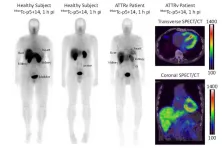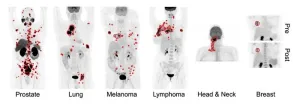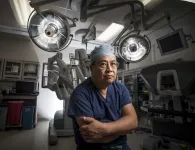(Press-News.org)
A bacterial enzyme called histidine kinase is a promising target for new classes of antibiotics. However, it has been difficult to develop drugs that target this enzyme, because it is a “hydrophobic” protein that loses its structure once removed from its normal location in the cell membrane.
Now, an MIT-led team has found a way to make the enzyme water-soluble, which could make it possible to rapidly screen potential drugs that might interfere with its functions.
The researchers created their new version of histidine kinase by replacing four specific hydrophobic amino acids with three hydrophilic ones. Even after this significant shift, they found that the water-soluble version of the enzyme retained its natural functions.
No existing antibiotics target histidine kinase, so drugs that disrupt these functions could represent a new class of antibiotics. Such drug candidates are badly needed to combat the growing problem of antibiotic resistance.
“Each year, more than 1 million people die from antibiotic-resistant infections,” says Shuguang Zhang, a principal research scientist in the MIT Media Lab and one of the senior authors of the new study. “This protein is a good target because it’s unique to bacteria and humans don’t have it.”
Ping Xu and Fei Tao, both professors at Shanghai Jiao Tong University, are also senior authors of the paper, which appears today in Nature Communications. Mengke Li, a graduate student at Shanghai Jiao Tong University and a former visiting student at MIT, is the lead author of the paper.
A new drug target
Many of the proteins that perform critical cell functions are embedded in the cell membrane. The segments of these proteins that span the membrane are hydrophobic, which allows them to associate with the lipids that make up the membrane. However, once removed from the membrane, these proteins tend to lose their structure, which makes it difficult to study them or to screen for drugs that might interfere with them.
In 2018, Zhang and his colleagues devised a simple way to convert these proteins into water-soluble versions, which maintain their structure in water. Their technique is known as the QTY code, for the letters that represent the hydrophilic amino acids that become incorporated into the proteins. Leucine (L) becomes glutamine (Q), isoleucine (I) and valine (V) become threonine (T), and phenylalanine (F) becomes tyrosine (Y).
Since then, the researchers have demonstrated this technique on a variety of hydrophobic proteins, including antibodies, cytokine receptors, and transporters. Those transporters include a protein that cancer cells use to pump chemotherapy drugs out of the cells, as well as transporters that brain cells use to move dopamine and serotonin into or out of cells.
In the new study, the team set out to demonstrate, for the first time, that the QTY code could be used to create water-soluble enzymes that retain their enzymatic function.
The research team chose to focus on histidine kinase in part because of its potential as an antibiotic target. Currently most antibiotics work by damaging bacterial cell walls or interfering with the synthesis of ribosomes, the cell organelles that manufacture proteins. None of them target histidine kinase, an important bacterial protein that regulates processes such as antibiotic resistance and cell-to-cell communication.
Histidine kinase can perform four different functions, including phosphorylation (activating other proteins by adding a phosphate group to them) and dephosphorylation (removing phosphates). Human cells also have kinases, but they act on amino acids other than histidine, so drugs that block histidine kinase would likely not have any effect on human cells.
After using the QTY code to convert histidine kinase to a water-soluble form, the researchers tested all four of its functions and found that the protein was still able to perform them. This means that this protein could be used in high-throughput screens to rapidly test whether potential drug compounds interfere with any of those functions.
A stable structure
Using AlphaFold, an artificial intelligence program that can predict protein structures, the researchers generated a structure for their new protein and used molecular dynamics simulations to investigate how it interacts with water. They found that the protein forms stabilizing hydrogen bonds with water, which help it keep its structure.
They also found that if they only replaced the buried hydrophobic amino acids in the transmembrane segment, the protein would not retain its function. The hydrophobic amino acids have to be replaced throughout the transmembrane segment, which helps the molecule maintain the structural relationships it needs to function normally.
Zhang now plans to try this approach on methane monooxygenase, an enzyme found in bacteria that can convert methane into methanol. A water-soluble version of this enzyme could be sprayed at sites of methane release, such as barns where cows live, or thawing permafrost, helping to remove a large chunk of methane, a greenhouse gas, from the atmosphere.
“If we can use the same tool, the QTY code, on methane monooxygenase, and use that enzyme to convert methane into methanol, that could deaccelerate climate change,” Zhang says.
The research was funded, in part, by the National Natural Science Foundation of China.
Written by Anne Trafton, MIT News
Paper: Design of a water-soluble transmembrane receptor kinase with intact molecular function by QTY code
https://www.nature.com/articles/s41467-024-48513-9
END
Juvenile social play predicts adult reproductive success in male bottlenose dolphins, a new study has found.
Fresh findings published today in Proceedings of the National Academy of Sciences led by researchers from the University of Bristol and University of Western Australia, show that juvenile male dolphins with strong social bonds practice adult-like reproductive behaviours when playing together, and those juvenile males who spend more time practicing will father more offspring as adults. The study provides rare evidence for a link between juvenile social play and reproductive success in a wild animal.
In collaboration with international colleagues, the ...
A research article published June 10 in the Proceedings of the National Academy of Sciences highlights the importance of careful application of high-tech forensic science to avoid wrongful convictions.
In a study with implications for an array of forensic examinations that rely on “vast databases and efficient algorithms,” researchers found the odds of a false match significantly increase when examiners make millions of comparisons in a quest to match wires found at a crime scene with the tools allegedly used to cut them.
The rate of mistaken identifications could be as high as one in 10 or more, concluded ...
Toronto, Ontario—Jean-Luc C. Urbain, MD, PhD, FASNC, professor of Radiology/Nuclear Medicine and Medicine, has been named president-elect of the Society of Nuclear Medicine and Molecular Imaging (SNMMI). SNMMI introduced a new slate of officers during its 2024 Annual Meeting, held June 8-11 in Toronto.
“As SNMMI president-elect, I plan to focus on bringing and integrating radiopharmaceutical theranostics into the clinic to benefit as many patients as possible. This will require an emphasis ...
University of North Carolina at Chapel Hill scientists have created innovative soft robots equipped with electronic skins and artificial muscles, allowing them to sense their surroundings and adapt their movements in real-time, according to the paper, “Skin-Inspired, Sensory Robots for Electronic Implants,” in Nature Communications.
In their research, funded by the National Science Foundation and the National Institutes of Health, the robots are designed to mimic the way muscles and skin work together in animals, making them more effective and safer to use inside the body. The e-skin integrates various sensing materials, such as silver nanowires ...
Beginning annually on June 1, hurricane season poses a major threat to Texas coastal communities, causing both physical and financial damage to the areas they hit. This damage can be staggering; when Hurricane Harvey hit in 2017, it cost Galveston $132.73 billion in damages. Texas A&M University researchers have collaborated to understand the impacts of storm surge floods before they occur to potentially reduce the level of damage. Their study was published in “Urban Informatics.”
The researchers have implemented 3D visualization technology to identify the potential outcomes of hurricane flooding ...
David Kepplinger, Assistant Professor, Statistics, and Anand Vidyashankar, Professor, Statistics, are set to receive funding from the National Science Foundation for: “Conference: Building a robust community: Joint International Conference on Robust Statistics and Conference on Data Science, Statistics, and Data Science.”
Kepplinger and Vidyashankar will receive $20,993 from NSF for this award. Funding will begin in July 2024 and will end in late June 2025.
The funding will support 15–20 students and early-career researchers to participate in the joint International Conference on Robust Statistics (ICORS) and the Conference ...
Toronto, Ontario—A newly developed radiotracer can generate high quality and readily interpretable images of cardiac amyloidosis, a condition referred to as the “Alzheimer’s disease of the heart.” As the first amyloid-specific and pan-amyloid binding radiotracer designed for planar and SPECT/CT imaging, 99mTc-p5+14 could play an important role in early detection and treatment of cardiac amyloidosis. This research was presented at the 2024 Society of Nuclear Medicine and Molecular Imaging Annual Meeting.
Systemic amyloidosis is an incurable disease in which abnormal amounts of ...
Toronto, Ontario—A novel AI approach can accurately detect six different types of cancer on whole-body PET/CT scans, according to research presented at the 2024 Society of Nuclear Medicine and Molecular Imaging Annual Meeting. By automatically quantifying tumor burden, the new tool can be useful for assessing patient risk, predicting treatment response, and estimating survival.
“Automatic detection and characterization of cancer are important clinical needs to enable early treatment,” said Kevin H. ...
An international team of astronomers led by the University of Vienna has deciphered the formation history of young star clusters, some of which we can see with the naked eye at night. The team, led by Cameren Swiggum and João Alves from the University of Vienna and Robert Benjamin from the University of Wisconsin-Whitewater, reports that most nearby young star clusters belong to only three families, which originate from very massive star-forming regions. This research also provides new insights into the effects of supernovae (violent explosions at the end of the life ...
LOS ANGELES — A new study guided by a renowned surgeon at City of Hope®, one of the largest cancer research and treatment organizations in the United States, demonstrates that robotic liver surgery can be a safe, outpatient procedure. In fact, 8% of the patients sampled in the analysis were discharged to go home on the same day.
“We have made so much progress in liver cancer. We can now deliver more cures and use less invasive treatment options. This study is proof that for the right patients and with the right tools — meaning robotic surgery — we can get people through a liver operation quicker and toward recovery and normal ...






